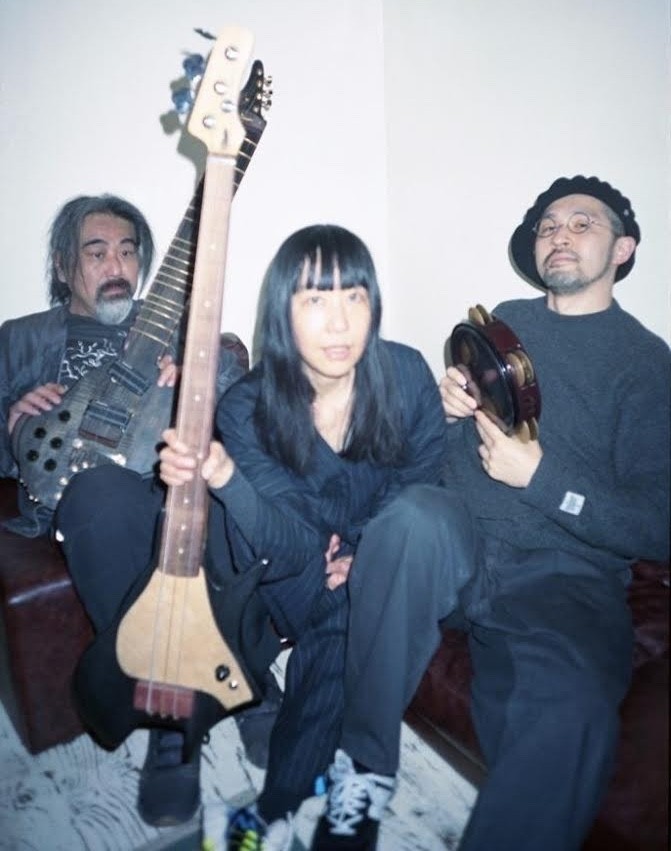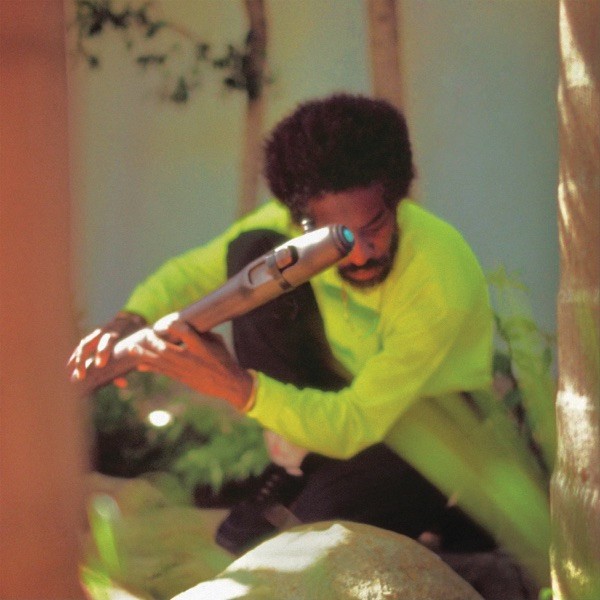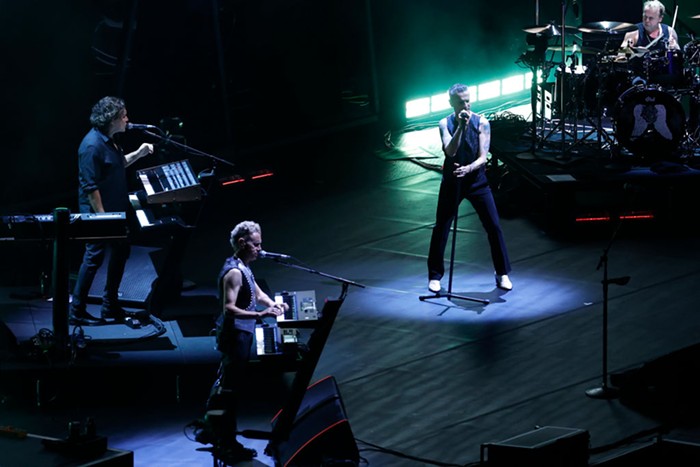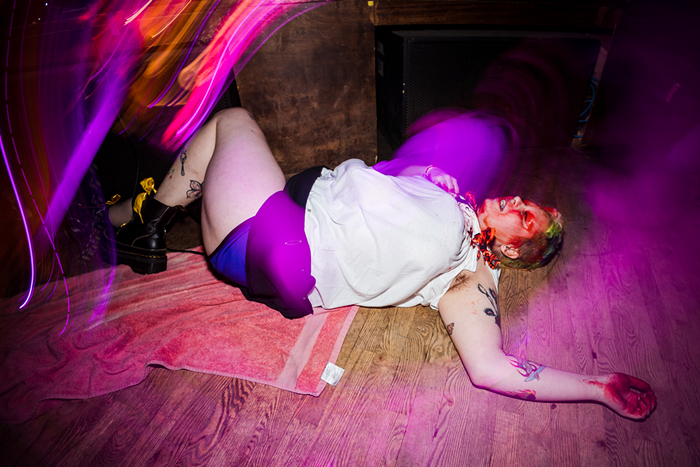Drums are said to have first appeared on Earth sometime between the Paleolithic and Neolithic Ages, around 8000 B.C. Humans stretched animal skins over hollowed-out tree trunks and struck them with sticks and bones. This primal heartbeat marked ritual and ceremony and warded off evil spirits. Ancient Mesopotamian drums called tribes to war. In Africa, beats ran up through jungles, sending messages and signaling the time of the hunt. Long ago, the Japanese spoke to their gods using taiko drums. In 3000 B.C. a Peruvian mountain man banged a gourd next to a fire pit to honor the meat of a feast. In 3000 A.D. a legion of drummers will be levitated in drum-pods a mile into the sky, and their syncopated playing will form a protective force field called the Sheen. Missiles won't be able to penetrate it. The more intricate the rhythm is, the stronger the shield will be. Through drums, destruction will be destroyed. It's a long way from goatskin and bones, but drummers will save the world.
On August 5, a Los Angeles art group called SceneFour released a project called Art of Drums, which depicts what drumming looks like on canvas. Ten drummers were chosen, including Matt Sorum (Guns N' Roses, Velvet Revolver), Frankie "Kash" Waddy (Parliament Funkadelic, James Brown), Chad Smith (Red Hot Chili Peppers), Rick Allen (Def Leppard), and Stephen Perkins (Jane's Addiction). Using long-exposure photography and lighted drumsticks, the drummers played for 30-second bursts. The sound and patterns were captured, rendered, and transformed from digital negative to print.
Frankie "Kash" Waddy spoke about his participation, and his saving the world with Funkadelic/James Brown gold.
What does the drumming look like in the images you created?
It freaked me out. Astronomical—the coloring, the movement, the strokes, the framework. There's attitude and mood. I did one that was peaceful and subtle, and one that's all over the place—fiery, excitable, and energetic. One was classy, with a lot of integrity. In one, you can see a horse-like figure. In the one that's real active, you can see the figure of a man walking through a darkened door.
What does a man walking through a doorway symbolize for you?
The piece is really big and intense. You have to look close to see the man. My girl actually brought it to my attention. She said, "Baby, look right here—it looks like a man." And sure enough, there he is. He's found the one opening, or the one way out, or the one piece of solitude in that whole frenzied piece. The portal. I don't know how I got that, through my playing.
Did you play differently for Art of Drums than if you were in a session recording?
I started out playing music and ended up painting portraits. My mind made a transition from being a drummer into being a painter. I became focused on movement and color combinations with the lighted drumsticks. Ten years ago, I never would have thought I'd be having this conversation with you.
Walk me back. How was it that you became James Brown's drummer?
We were studio musicians in Cincinnati at King Recording Studio. We were still in high school and would tour with different acts on James's roster. James was having trouble with his band and was making a switch. So he flew Bobby Byrd to Cincinnati in a Learjet to get us. The night before, we played a place called the Wine Bar for $15 total. The next day, Bobby Byrd put us in a limousine and shot us to the airport. We never even went in the direction of the airport, it wasn't in our vernacular—we didn't fly. [But] we flew to Columbus, Georgia, and they took us to this big venue. It was the National Guard Armory. We went in the back door. On the left side was the dressing room with all the cats we idolized—Fred Wesley, Maceo Parker, Kush Griffith. On the right-hand side, it was James's dressing room. It all happened quick. We had just flown and been in a limo for the first time. They shoved us to the stage, and it's the biggest crowd we'd ever seen. We gathered in a little huddle to play because we were used to being on such small stages. James came onstage, counted off a song, and that was that.
After the show, James screamed, "Y'all did great! Y'all killed me!! I'm going to give you $225." And we were happy with that. Then he said, "Naw, I'm gonna give you $250." And we thought, "Wow, a raise that quick!" Anyway, he did this counting all the way up to $450. The whole time, we were writing the amount on paper. Finally, James said, "What is that y'all are writing down?" We had to write it down so we knew how much to divide up between us. James laughed out, "Naw! You ain't splittin' nothing. That's for each of you!" Good money.
We had an old Dodge station wagon. We went from that to a Golden Eagle bus and a truck stocked full of brand-new Vox equipment. James and the Beatles were the only ones that had Vox endorsements. We had three changes of uniform, matching shoes... it was a trip. We were pinching ourselves like crazy because we couldn't believe it.
Catch me up to date on yourself. What's the latest?
I just came off of an amazing tour with Bootsy's Rubber Band. And I put together a band called the Funk Unity Band. A spin-off of the Funk University. We've been touring a lot. Bootsy is back with it for the first time in years. I got him passionate again about music. He and I have a thing that's so special. We're brothers. We've been through everything together. We went through James Brown, then to George Clinton's Funkadelic together. We've always made sure that he, his brother Catfish, and myself stayed together. When Bootsy and I play together, it's a no-brainer. It just works.
What did you do to get Bootsy inspired again?
First of all, I gave him his space. One thing I did was to play a show at this place on Sunset Boulevard called the Key Club. It was for Billboard Live in conjunction with Warwick basses. It's an annual thing with all these other bass players—all the major cats. I played with 12 bass players that night. Billy Sheehan, Nathan East [Eric Clapton], Victor Wooten. Then all of them played at the same time. I put the show together so Bootsy would feel that thing he hadn't felt in a long time. He loved it. He went out into the audience and was kissing and hugging people.
What makes you and Bootsy such a good rhythm section?
One of the major factors is the one. How we gravitate and generate, and accelerate from the one, and back to the one. And we just know each other so well. We've done everything together our whole career. We always had a small group. We didn't have a lot of money, and we couldn't afford a lot of people, so we had to play really tight. Everything had to be compound, and big. We talk from time to time about it, and we actually try not to figure it out. That way we won't mess with it. It just is.
What's your favorite James Brown song that you've been a part of?
It would have to be "The Grunt." One of only two instrumentals recorded by the original J.B.'s lineup with Bootsy and Catfish Collins. That one is so important to me because my father had had a talk with James about his intentions with us. And James said, "You know what? I'm gonna give them that song. I'm gonna let them have it." And he did. He made that song ours. He gave us all the rights and publishing on it. I'm still getting royalties on it to this day. James was a man of his word. He did what he told my father he was going to do.
James was made for music.
Yes. And we stayed with him as long as we could. He was older. We were real young and wild. We learned the world from him. Something not a lot of people know is that while we were with James, Jimi Hendrix was wanting us to be his band. He wanted a more black act, after being with [Noel] Redding and those guys. Jimi needed us to quit James, though, and he was going to pick us up. I was game, but the other guys didn't feel good about having to quit James.
It all worked out. We ended up then being in Funkadelic, which was a real free musical situation. With James it was a more strict, militaristic, disciplined type thing. With George Clinton, he was like, "Do whatever you want to do. Don't ask me nothing. If you can think it, you can do it." We went from one extreme to the other. We brought that professional discipline to Funkadelic. And it's still working. I'm still with P-Funk. And I'm still with Bootsy's Rubber Band. I'm the link between both groups.
What's your favorite Funkadelic song you've been on?
I'd say "Bop Gun." There are a lot of live recordings of that one that came out. That song had significance. I think it still stands up.
What was a Funkadelic session like?
George ran it like a factory. There would be two or three rooms going, and whoever got in there first would start putting their stuff down. Whoever wanted to join in did. Some of them came out really, really good. And some were just okay. But the great ones were worth it. Funkadelic recording was like an assembly line. One group of guys would record, then there'd be another group of guys waiting in the next room to lay down their thing on top of it. We went on like that forever. And while we were in the studio, we wouldn't listen to the radio or watch TV. We didn't want to be distracted or infected by anything. We didn't want to sound like something that was already out there.
I think Funkadelic accomplished that goal.
Thank you. I do too. ![]()
This article has been updated since its original publication.



















